GQ's Best New Restaurants in America, 2019
Let me begin with two dinners in Houston. These were two meals over the course of 24 hours that felt like they summed up what it meant to eat in America in 2019. It was not surprising that they took place in a city I've come to believe is not only one of the country's best food cities but also, increasingly, a bellwether of where its dining winds are blowing.
So: Night One found me at Georgia James, the steak house opened in October by Chris Shepherd in what used to be his James Beard Award-winning flagship, Underbelly. It is a palace of unrestrained pleasure as maybe only a steak house can be: loud, buzzy, giddy, awash in beef and whiskey and oil money. Call it Big Derrick Energy. The signature item at Georgia James, though it is not printed on the menu, is the Baller Board: a wooden plank that on any given night will be heaped with some combination of steaks, other beef cuts, pork shoulder, lamb chops, whole fried chickens, boudin-stuffed quails, duck legs, cow hearts, lobster tails, crab claws, and God knows what other leftovers from a medieval post-hunt still life. (Prices vary, but if you have to ask…) Viewed from above, the boards resemble primitive fertility totems, complete with the priapic bone of a porterhouse thrusting up from the center. Over the course of one dinner, I must have seen ten paraded out to tables around me.
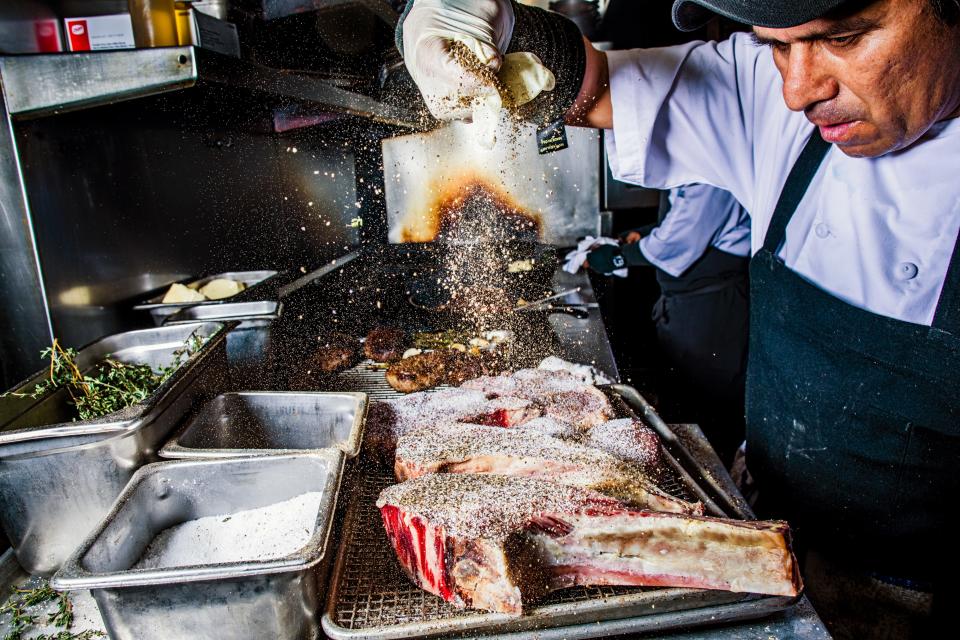
The joke on the ballers is that everything here is baller. And everything, if you squint, is kind of a steak, from the huge Center Cut King Crab Legs, which restore the crown of that crustacean after too many dissolute years spent hanging around Vegas buffets, to the Slab Salad, a classic iceberg wedge topped with ranch and Benton's lardons that somehow inspires you to attack it with some of the same bloodlust you do the deeply crusted rib eyes, strips, and porterhouses, or the 100-day-wet-aged wood-grilled hanger, which is the sneaky winning order. Shepherd, who this year also opened UB Preserv, a new evolution of Underbelly, as well as a “Mediterranean” iteration of his rotating concept, One Fifth, has a gift for deliciousness but not always for coherent editing. The conventions of a steak house seem to have focused his fertile mind. The candle on my table turned out to be a wick floating in a limpid pool of clarified smoked-brisket fat. Bread dipped into it came out tasting like a barbecue rib. I suspect so would kale.
Almost exactly 24 hours later—Night Two—I was seated at the poured-concrete, U-shaped counter of Indigo awaiting a dish called Homogenization of Mandingos. It hadn't been easy to find the restaurant, located in what looked from the road like the unoccupied half of a convenience-store strip mall in Northline, well outside The Loop. Once inside, I found a warm but spare room with a cinder-block wall painted copper-orange. Like everything else at Indigo, the room was the conceptual and physical construction of its precocious young chef, Jonny Rhodes, and his wife, Chana. Rhodes grew up a half-mile away, served time in the Marines, and then got his cooking education from a series of kitchen stints and what he calls “YouTube University.” He imagines Indigo as the first stage of an oasis in the area's food desert, that will come to include a greenhouse and micro-farm on the property as well as the adjacent grocery store. For now, he is content serving three tasting menus—Carnivore, Herbivore, and Omnivore—which function as his own sometimes impressionistic, sometimes literal history of the African diaspora. Rhodes introduces his dishes with discursive monologues of context. We had already eaten Descendants of Igbo, a tribute to the African yam made with pureed sweet potato and smoked pecan butter. Also, a dollop of sweet crabmeat lolling in a warm pool of milk and butter that bore some tangential relationship to the dress of assimilation, called Turtle Necks & Durags. Rhodes is a charming and magnetic lecturer, but also a gifted cook, with a deft grasp of how to balance high concepts with equally compelling technique and flavor. Now it was time for the Mandingos. The origin of that loaded term, Rhodes explained, was in a West African hunting-and-gathering people. Only in America, where the slaves who shared their physique were simultaneously prized and feared for their strength and power, did it become a racial epithet.
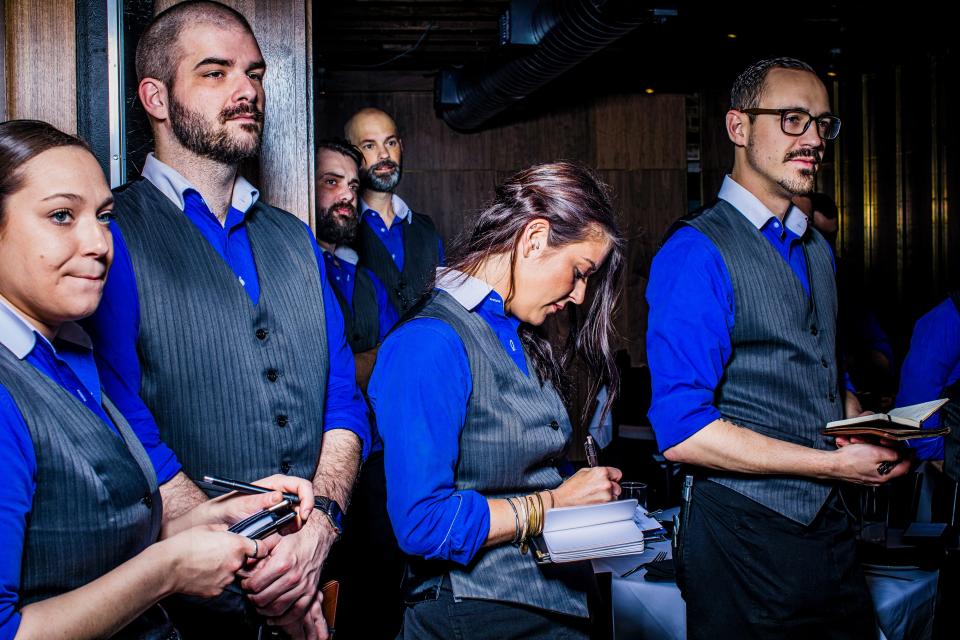
“Black men, as we know, have been hyper-sexualized as a way of maintaining that fear,” he went on. “And part of that is the idea of giant, threatening black penises.”
It occurred to me that I would never again be able to feign interest in a server's rap about “how our menu works.” Rhodes allowed himself only the smallest smile as the dish was placed before us.
On the plate was an inch-long stub of dark sausage.
Here, I thought, driving home after this second meal, was the entire whiplash experience of the year in dining: All the back-and-forth between heart and brain, pleasure and intellect, comfort and confrontation, wit and vulgarity, the desire for escape and the hunger to be challenged. Restaurants have become some of our most charged public forums—spaces fairly crackling with issues of race, gender, labor, the environment, immigration, and more—while remaining among our most private and emotional. They are places where it really wasn't all that unexpected to hear a dissertation on the uses of psychosexual paranoia in racial domination, but also where one might indulge the legitimate pleasures of spending hard-earned money on way too much perfectly cooked meat. Driving through the Houston darkness, I felt lucky anew to have the chance to love them both.
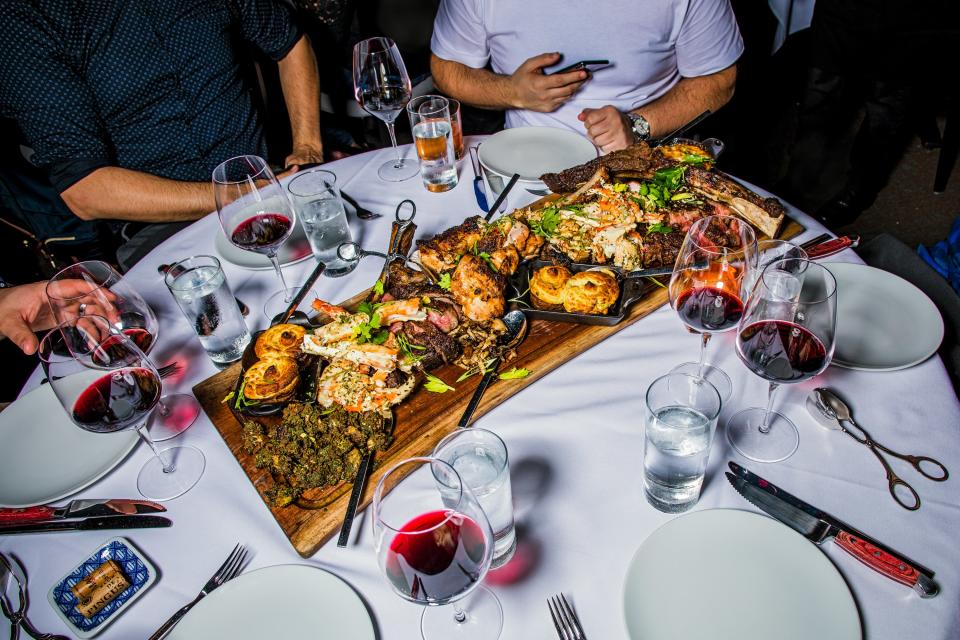
It's worth mentioning that between those meals, I'd eaten Malaysian curry in a suburban mall, a near perfect pork rib served from a bright red food truck parked outside a bar, and extraordinary Central Texas-style smoked brisket in a brand-new barbecue joint opened by Chinese- and Vietnamese-Americans. All in all, a not untypical day in the three months I spent crisscrossing America in search of the most exciting, stimulating, and outright delicious restaurants to open in the past 18 months, give or take. It's my personal version of my favorite musical genre: the Great American City Singalong. I can't say I've quite been everywhere (man), but I did go from Phoenix, Arizona, all the way to Tacoma—or at least to Sea-Tac. New York, Los Angeles—how I yearned for you, through the long nights of the polar vortex in Chicago, Indianapolis, Toledo, and St. Paul. Don't forget the Motor City! And get me to the Promised Land of the perfect restaurant experience.
It's a big country, and one of the very things that have made it more exciting to eat in than ever—the decentralization of culinary energy from big coastal cities and into every nook and cranny of the continent—has made it all the more absurd to attempt to cover with anything like completism. It's a messy country, too, in case you hadn't noticed, often seeming to move in every possible direction at once. That is the challenge to my other purpose on the road, which is to attempt to divine something along the way about the State of our Union, on the plate and otherwise. And yet, I manage to have more extraordinary, inspiring restaurant experiences each year than I am able to capture here. And somewhere along the line, inevitably, some piece of data—a dish, a cooking method, a design element—bubbles up that seems to tell a bigger story.
This year, it started in the bathrooms.
All of a sudden, those once spare spaces—a candle burning, perhaps a dried plant, a letterpress card insisting that employees wash their hands—exploded into riots of graphic excess. The wallpaper alone! Jungle scenes and palm trees! Lobsters and sharks, birds of all varieties, bursting fields of flowers! Some nights it was like trying to pee while surrounded by a phalanx of large men in Hawaiian shirts, or like being buried alive in a Gucci sarcophagus.
Once spotted, this new exuberance was impossible not to notice back out in the dining room: I dined beneath jungle canopies—greenery protruding from the walls, vines stretching down from the ceiling, not altogether benignly. I ate off mismatched, wildly printed granny china, as if at a Mad Tea Party. All of this has been duly noted by the watchers of design trends and, on the one hand, it's merely a predictable cyclical turn: Ties expand; ties contract; ties disappear. Minimalism gives way to ornamentation. One day you've got naked ducts and unfinished concrete; the next you're in a community-theater production of Little Shop of Horrors.
At the same time, I began to sense that there was something more at play. Maybe it was the moment, in a New Orleans restaurant, when a dancer fully clad in Brazilian Carnival dress went strolling past our table and nobody broke conversation. It occurred to me that I had been at the carnival for months. Our restaurant-comfort moment seems to have morphed into a circus moment. Sometimes all that wallpaper feels like a joyful expression; other times, like a warm embrace. But often it also feels like a mouth frozen open in a grin of barely contained hysteria.
Like many people, I've spent the past two and a half years viewing American life through the filter of the Donald Trump presidency and all it represents. In the dining world, that has largely meant two obvious categories: Restaurants of Refuge (like Georgia James) and Restaurants of Resistance (like Indigo). I'm suggesting a third classification of restaurants that more directly hold a mirror to the anxiety and surreality of the present moment. I call them Restaurants of Derangement. And why not? It's become a cliché to note that the root of restaurant is “to restore”—but not only things made nice (to use another buzz phrase) can be restorative. We like rom-coms but also horror movies, Norman Rockwell but also Otto Dix, holding hands in the tunnel of love and white knuckles on the roller coaster.
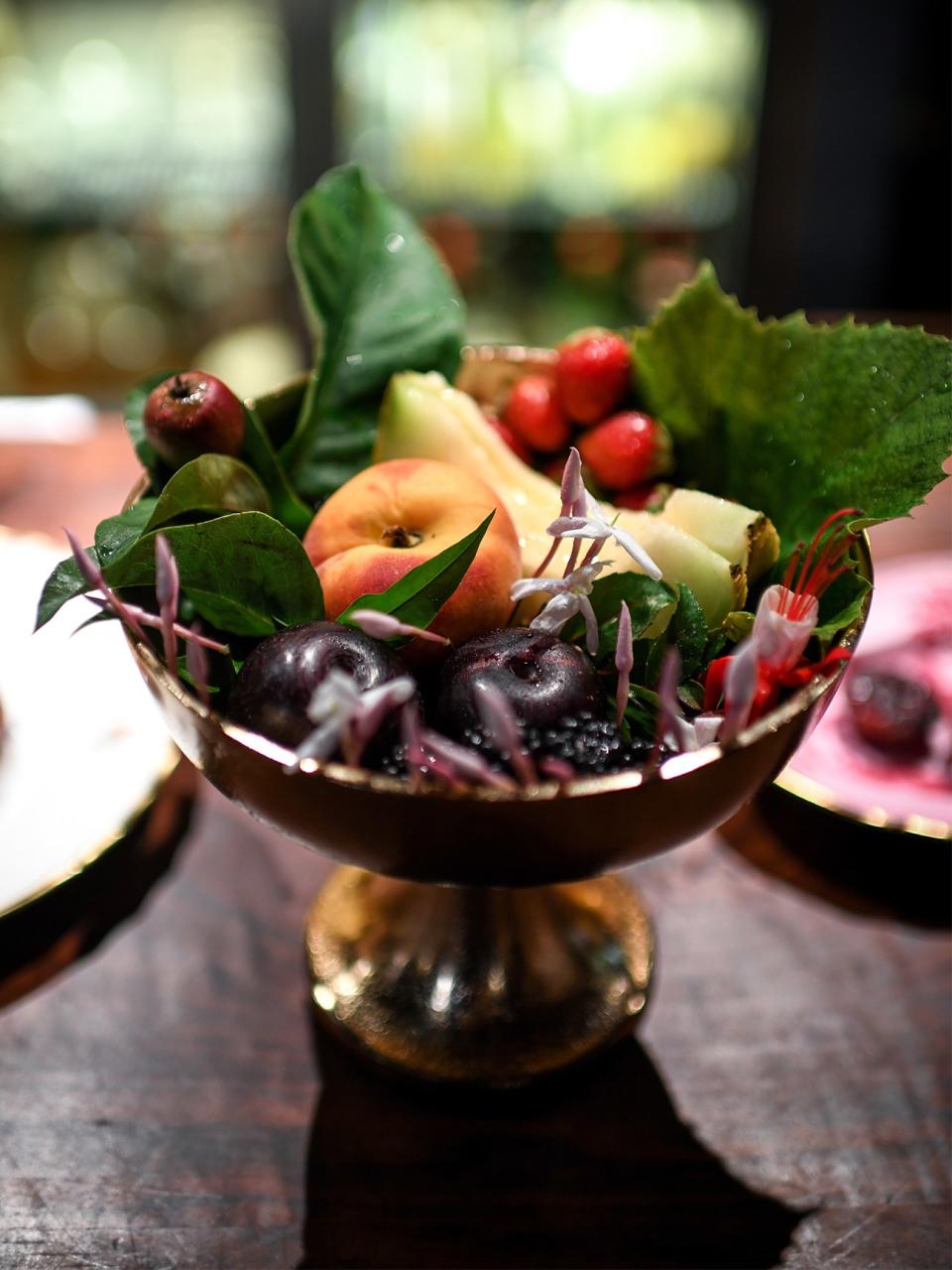
For me, that was the key to decoding Angler, Joshua Skenes's shiny, theatrical fine-dining seafood house on San Francisco's Embarcadero. I'm not suggesting that an afternoon spent eating immaculately shucked oysters while overlooking the Bay Bridge isn't a luxurious comfort. But look around and you can't help but notice that the place is kinda weird. The open kitchen that stretches across the entire back of the space is hung with copper pans, bundles of herbs, and dried fish dangling from twine. It looks like a collaboration between Escoffier and the set dresser from Pirates of the Caribbean. A back room is styled as a hunting lodge, filled with taxidermy (not just the kind you find in dime-a-dozen Brooklyn bars, either; there's a full bear). The soundtrack is straight '80s classics, the kind you think are irritating until you find yourself singing along. The weirdness continues on the plate. Antelope tartare appears in a thin disc as glossily crimson as pomegranate seeds, to be scooped up in lettuce cups flecked with herbs. It is exquisite. Parker House rolls come to the table crammed into a silver bowl like a hiding octopus. You receive a cloth bib, which you fasten with lovely alligator clips before attacking a grilled head of radicchio filled with beet juice, fried shallot, and an XO sauce made from its own core. The dish leaves you with blood-red vampire teeth. Then, as though a switch has been thrown, the kitchen suddenly swerves into minimalism. For main courses, the printed plates are replaced with plain white plates. Seafood appears on them almost unadorned: striped bass beneath a plank of scored, perfectly crisp skin; scallops cooked to the precise balance of firm and wobbly that almost gives the impression they are breathing. The same simple butter sauce comes on several preparations, accompanied by a muslin-clad half-lemon, as though you're suddenly at Tadich Grill, the classic seafood house a half-mile away, or Galatoire's, in New Orleans. It is a move that's immensely confident, and not a little unhinged.
Angler is nominally a more accessible companion to Saison, Skenes's much-lauded Michelin three-star tasting-menu restaurant, but it would be absurd to call it casual in price or style. It took until midway through my meal at Angler to realize the unlikely place it reminded me of most: Danny Bowien's Mission Chinese Food, in New York City. That was another fully realized, utterly consuming manifestation of one chef's idiosyncratic view of how to eat. Bowien was channeling some of the scruffy, bohemian, psychedelic roots of the San Francisco where Mission got its start. Angler feels more honest about what San Francisco is today: an often dystopian metropolis of vast tech wealth where, over the past five years, I've largely eaten in places with too much capital, too much square footage, and too little soul. For better or worse, Angler feels like the first great restaurant of this new city.
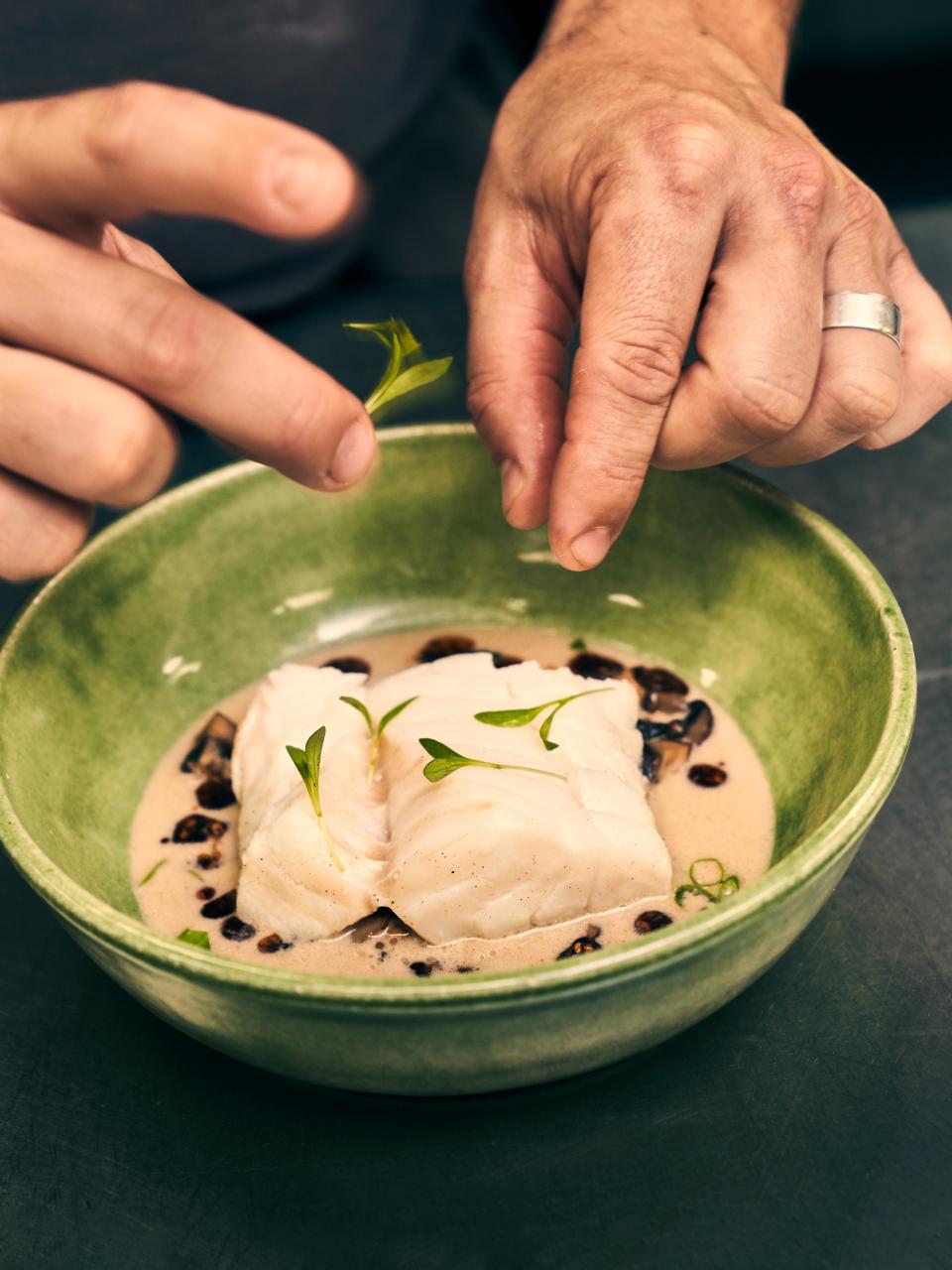
There were other hallucinations and exhilarations everywhere I went. I arrived in San Juan, Puerto Rico, 16 months after Hurricane Maria devastated the island, to find a city still in recovery but fairly bursting with creative energy. That “America's Best New Restaurants” should self-evidently include Puerto Rico's Best New Restaurants was a point perhaps perversely made by the generic-ness of the dining room at Vianda, which, with its gray walls and Edison bulbs, could be found in any city in the American Midwest. It's all a front for chef Francis Guzmán's thrilling savagery on the plate, a feint replicated by the innocent-looking bed of salad that arrives atop a blood-infused crepe filled with slippery bits of pig's head and trotter, the carnal richness cut by a vinegary bed of pigeon pea “escabeche.” Guzmán and his wife and partner, Amelia Dill, worked at Blue Hill in New York, among other fine-dining restaurants, before deciding to return to the island where he was born. They were six months out from opening when Maria hit—in too deep to quit. Amazingly, the opening was delayed only three months. Guzmán celebrates Puerto Rican cuisine in dishes like a mound of mofongo studded with littleneck clams, while never shying from the technique of his training or inspirations from farther afield. “Tom Kha” Bacalao—a piece of cod served atop coconut milk, mushrooms, chile oil, and crispy rice—makes a compelling case for a new Golden Triangle, between Spain, Thailand, and the Caribbean. I left San Juan feeling sure that Puerto Rico would be producing Best New Restaurants for years to come.
Back on the mainland, I continued to encounter hallucinations and exhilarations, small and large. In Miami, I stepped off the sidewalk and into a streetscape of 1950s Santiago de Cuba: laundry hanging from the balcony of a worn yellow apartment façade; the cab of an old pickup truck holding a leather banquette; a stage for the performance of La Trova, the classic music style invented in that second-largest city in Cuba. The restaurant is named for that music, Cafe La Trova. As its co-owner, the great Cuban bartender Julio Cabrera, explained it to me, the entry room, where live music plays on the weekends, is meant to evoke nostalgia for pre-Castro island life. The next room, hung with movie posters and records, he went on, represents the early days of exile in Miami. Finally, in the back, there is an '80s-themed bar, complete with a neon palm tree and a Miami Vice poster. All of this would risk pure kitsch if it weren't for a few things: First is Cafe La Trova's location on Calle Ocho, the heart of Miami's Little Havana. Second is Cabrera himself, who grew up in his father's bar in Cuba and has become the pre-eminent ambassador of the island's elegant cantinero tradition around the world. Cabrera got his start as a bartender at James Beard Award-winner Michelle Bernstein's restaurants (including Michy's, in Miami), and she is his partner at this, his first restaurant as owner. She has loaded the menu with soulful classics: supple-crusted empanadas filled with steaming pockets of shredded steak mixed with olives and caramelized onions; a “proper” butifarra sausage, lusciously fatty and served in slices over sherry-scented gigante beans; fat shrimp cooked in garlicky sofrito; stellar arroz con pollo. All of it is delicious, but the stage really belongs to Cabrera and his fellow tuxedoed cantineros as they simultaneously shake classic daiquiris, Papa Dobles, and other immortal drinks for a crowd that is equal parts young-and-beautiful couples and the men in fedoras you see by day playing dominoes farther down Calle Ocho. Even in the morning—when Cabrera's wife operates a counter in front, serving Cuban coffee and guava-filled pastries—the place buzzes.
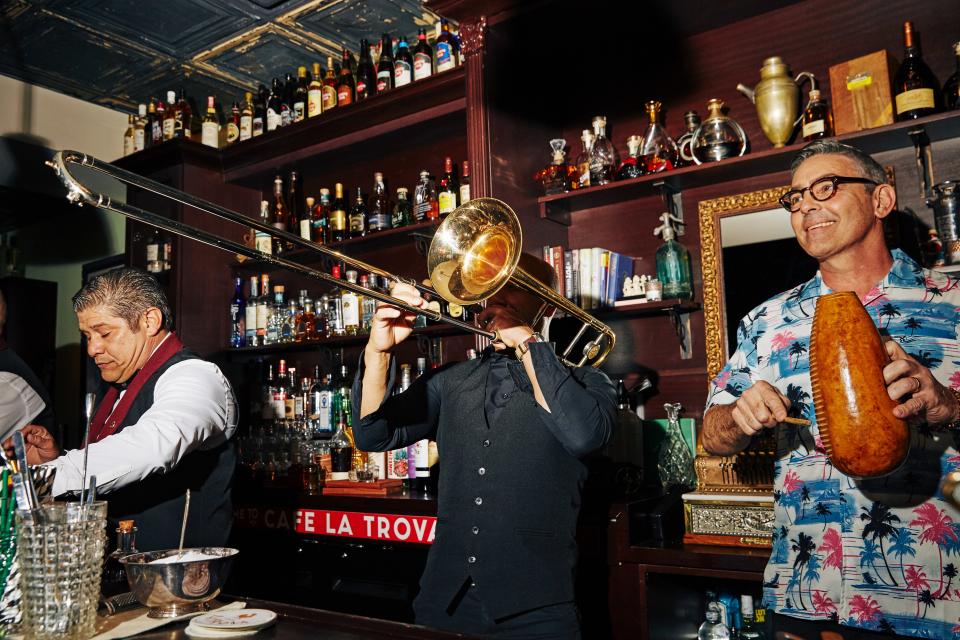
Going from Little Havana to the littlest state, sun-soaked Miami to flinty midwinter New England, I squeezed into Big King, the self-described “small weird restaurant” in Providence, Rhode Island. The narrow room has the relaxed feel of a neighborhood sushi joint; there's a “chef's counter” that, farther down, turns into a bar. Most of the food arrives from the tiny kitchen in back. The two set menus, one of four courses and the other of six (supplemented by a handful of à la carte items) are handwritten in a notebook each day, sometimes in the form of flowcharts. At $40 and $55, they are a remarkable deal. Each is a parade of precisely executed Japanese dishes filtered through the brain of chef James Mark. There was a bowl of warm kabocha squash, covered with a layer of wobbly egg custard and a bright cap of leek oil and cured egg yolk; a finger of barely blanched lobster, dressed with a silky emulsion of soy milk and aged hot sauce and a scattering of poppy seeds; tempura rings of delicata squash, light and greaseless enough to pass muster in any restaurant devoted to that frying discipline. Though there is a small selection of shochu cocktails and other beverages, Mark would like you to drink sake. (“One doesn't walk into a taco shop and ask for Quenelles Lyonnaise,” he writes on his restaurant's FAQ.) The sharpness and depth of the sake pairings make it easy to submit.
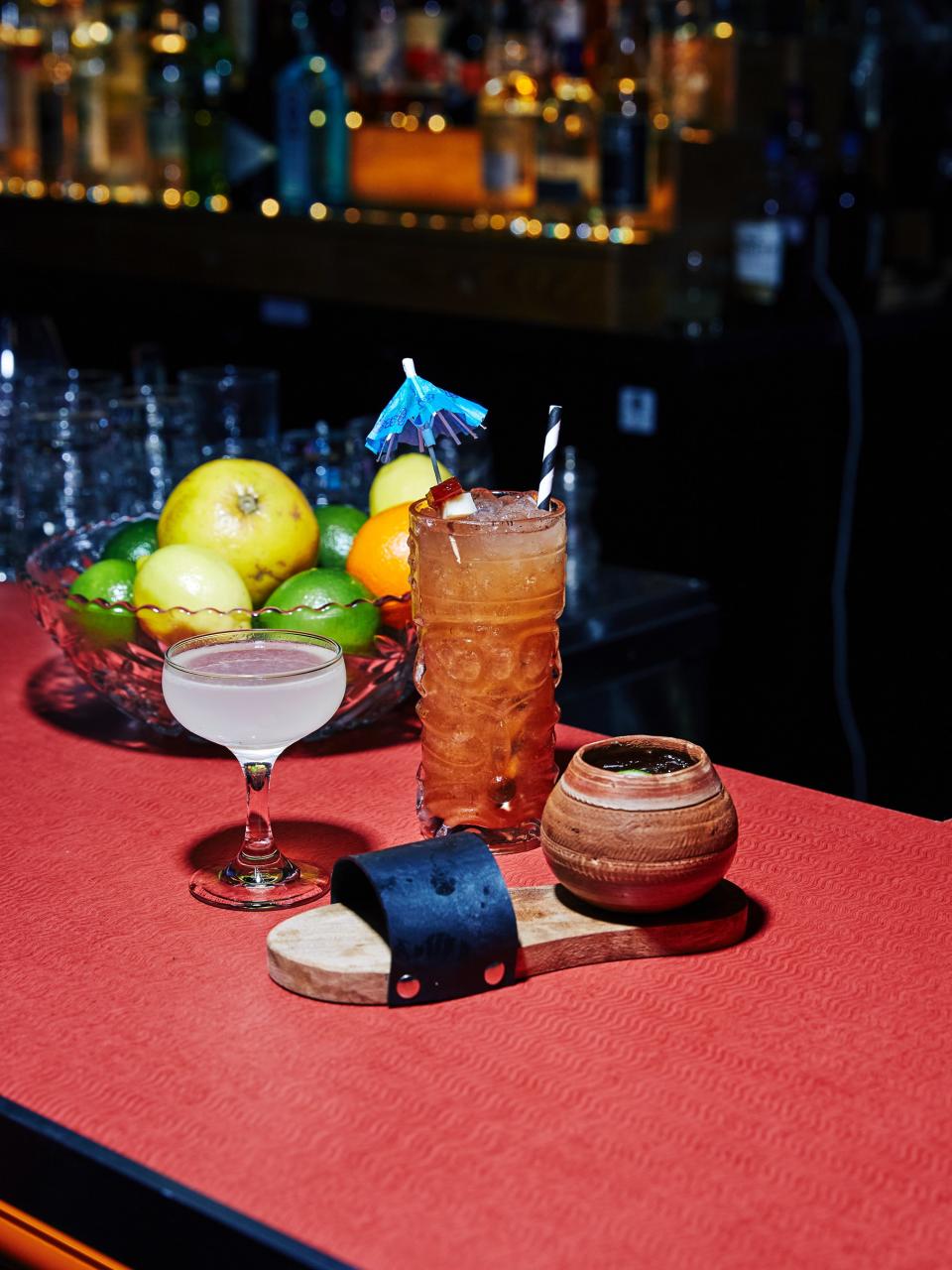
On the other side of the continent, I landed at warm, comfortable Homer, in Seattle's Beacon Hill neighborhood. After half a decade of ubiquitous wood-fired Mediterranean and Middle Eastern small plates, not to mention enough hummus to drown in, I didn't think that genre had any surprises left to impart. That was before I ate the lamb ragù here—an almost unbearably rich and smooth mélange of barnyard and spice route, nestled beneath a blanket of feathery winter herbs. Lots of places have hardworking wood ovens these days, but I never saw one perform such impressive clown-car duty as Homer's, which anchors one end of a bright open kitchen. At its door, a chef labored like a stevedore, arranging and re-arranging puffed saucer-sized discs of chewy pita, bubbling vessels filled with vegetables, and at one point an entire hotel pan of roasting lamb bones. Even as, year after year, Seattle seems to slide further into moneyed tech-industry domination, it also seems to produce a steady flow of excellent neighborhood restaurants. Homer is one that makes you wish its neighborhood were yours.
There's a similarly comfortable vibe at Alewife, in Richmond, Virginia, a city that has forced its way onto my dining map lately. I ate extremely well in Richmond; drank well, too, since the city is a hotbed of cocktail culture. That's what got me in the door at Alewife, where the bar serves a southern-minded array of expertly mixed drinks. I stuck around for what comes out of Lee Gregory's galley-sized kitchen: clean, honest dishes from that magical sector where the waters of the mid-Atlantic swirl and merge with those of the South. The best was a simple plate of fried “sugar toads,” the felicitous nickname for small blowfish. Pulled from the Chesapeake Bay, they were firm and meaty, like a cross between cod and frogs' legs, and came encased in a crust of cornmeal and Old Bay. Alewife wears its nautical theme lightly—a few tiki masks, mirrors suggestive of portholes, a drawing of Robert Shaw in Jaws. Though I know rationally that Richmond isn't on the coast, I can't help remembering it, up on the top of Church Hill, as a warm place where you might gaze at the horizon, watching for returning sailors.
I was never entirely able to get the name of chef JJ Johnson's restaurant in Midtown Manhattan to roll off my tongue: Henry at Life Hotel by JJ. Perhaps commas would help. But I won't soon forget the crisscrossed stack of glistening bone-in short ribs with which Johnson, who made his name at The Cecil and the supper club Minton's, both in Harlem, caps his exuberant menu exploring the farthest reaches of the African diaspora. It's rare that you find a restaurant whose main courses feel more exciting than its appetizers. Henry is one, not least because of the way those ribs overshadow a parade of more generically “global” starters. Likewise, an inspired dish of roasted scallops, standing tall and holding their own flavorful weight against a tide of deep hominy broth and pieces of salty, meaty pork belly, or moist-fleshed, sticky-skinned jerk chicken, on which the flavor of tamarind plays a duet with the more traditional notes of clove and allspice. There's a clubby feel to the low-ceilinged room, an unusual intimacy for a place in the lobby of a hotel, and a '90s-heavy hip-hop-and-R&B soundtrack that the Times reported can play for 20 hours without repeating. For some reason, that factoid pleases me: the notion that the party might be moving forward at any hour of the day. It's also a reminder that there is more than one way to tell the story that Indigo, in Houston, was telling, way back in the beginning of my travels. There are, of course, thousands.
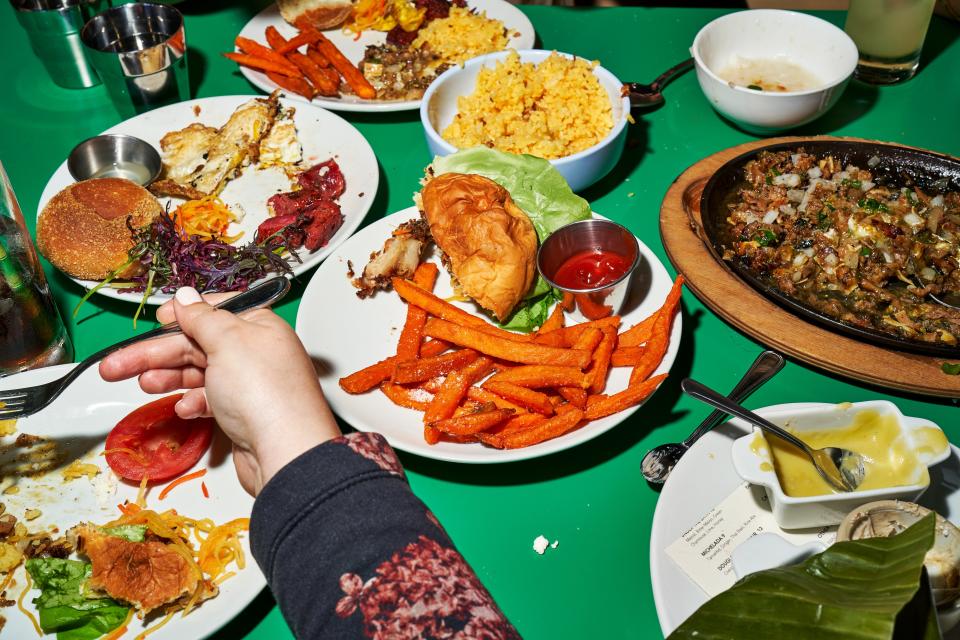
It was stranger than anticipated to eat my way through Los Angeles for the first time since Jonathan Gold, the great L.A. Times critic, died unexpectedly last July. It could be maddening to know that wherever you went in that great city, he had surely passed that way before you (the same was true of everywhere else in the world with Anthony Bourdain, who left us the month before), but it was also somehow reassuring.
Strange, too, to feel a change in the restaurant scene in L.A. for which Gold certainly deserves a heaping portion of credit. It was only recently that one still had the feeling of plumbing an undiscovered, or at least unexpected, country in Southern California, an underdog status that now seems unspeakably dated. “We view Los Angeles as the nation's food capital,” the executive editor of the L.A. Times said recently, to which nobody appeared to blink an eye. As Garrett Snyder, the food editor of Los Angeles magazine, put it to me, “We're no longer the scrappy team that makes a playoff run. We're the Golden State Warriors or New England Patriots.”
Already operating in confident championship form was Ma'am Sir, the new Filipino restaurant from Charles Olalia at the nexus of Silver Lake and Los Feliz. Back in 2015, Olalia left the fine-dining world to sell extraordinary Filipino rice bowls and other snacks in a grain-sized luncheonette space in Downtown. Ma'am Sir returns him to a dining room, and it's a riotous one, draped with hanging vines and lit by swinging fixtures caged in woven baskets. One wall is covered in bright blue-and-green wallpaper that brings to mind M. C. Escher fish. Another features framed photos of Filipino soccer and movie stars. I have been intrigued, but never quite swept away, by Filipino cuisine, as it has become more and more prominent around the country in recent years. That began to change when I tasted Olalia's version of classics like lumpia, the deep-fried spring roll served here open, like a narrow marrow bone, and topped with a nub of sea urchin. Likewise, his sisig, a sizzling platter of Instagram-defeating browns: pigs' cheeks, snout, and ears, blended with veal sweetbreads, onion, chile, calamansi, and more, in layer after layer of alternating flavor and texture that I've thought of nearly every time I've been hungry since.
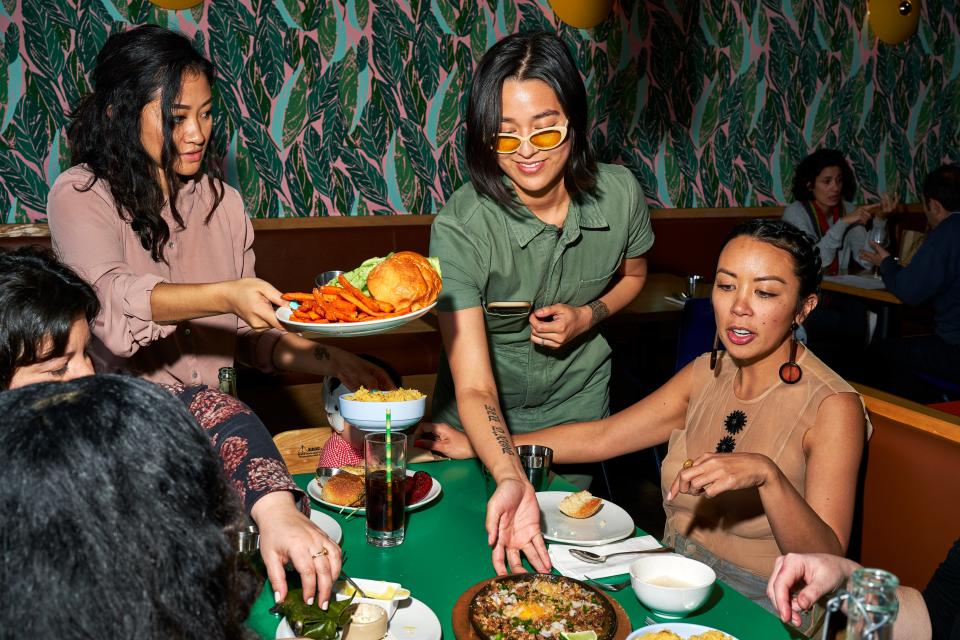
I think, too, of the mapo-tofu lasagna at Mei Lin's Nightshade. Maybe it once would have seemed strange to arrive at a restaurant by heading down a dark, deserted-seeming warehouse alley, beckoned by a single neon sign. These days it seems par for the course. Inside, the place is smooth and inviting, all blond wood and upholstered chairs that bring to mind a stylish therapist's office. I settled at the bar, but before yielding to the pleasure of that lasagna, I needed to get past the dish of Lin's that's gotten the most attention: a take on Outback Steakhouse's classic Bloomin' Onion, served here coated in tom yum powder and alongside a coconut ranch dressing, neither to any discernible transformative effect. It's a weighty dud and an object lesson in the perils of chasing that “one Instagrammable dish.” Had I stopped there, I might have dismissed the restaurant as just another purveyor of glib high-low stunts. Luckily, I stayed and, of all things, a kanpachi crudo, now a practically mandatory snoozer on menus everywhere, turned things around. It came concealed beneath a white blanket of perfect circular slices of radish, like scales, the fish beneath ever so slightly taking on the flavor of the radishes and a hint of kimchi. Then came the lasagna, which I am not putting in quotes because—despite being constructed of layers of noodle so delicate they resemble tofu skin and filled with Sichuan-peppercorn-laden mapo, in place of ragù—it eats so convincingly like its namesake. Nightshade also serves some of the most visually stunning desserts I saw all year. The pot bubbling and steaming behind the chef's counter may look like a cauldron of congee, but it contains liquid nitrogen for the fashioning of bright orange mandarin sorbet into graceful nesting bowls. Need I say there was a curious tendril of ivy reaching down from a shelf above me as I ate?
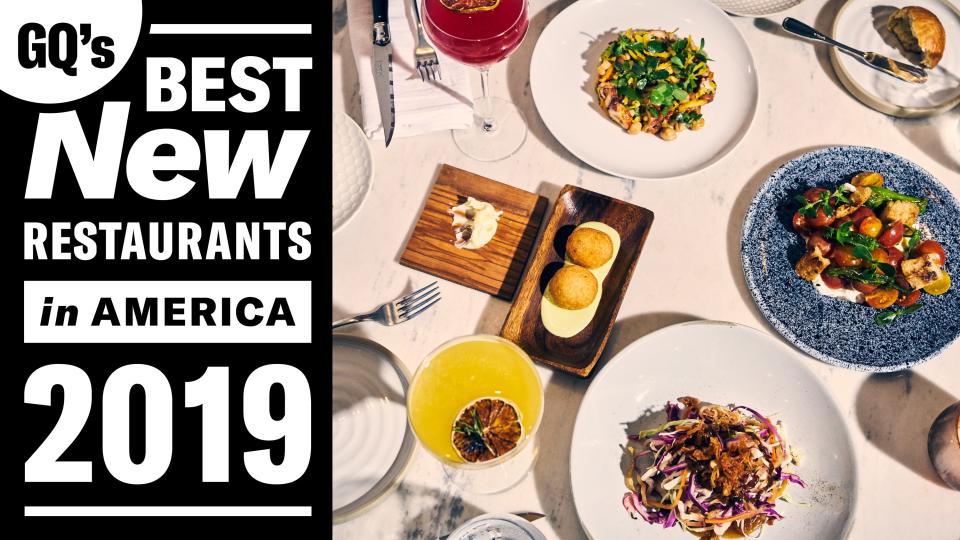
(In alphabetical order)
Alewife, Richmond: A homey house of seafood where the mid-Atlantic meets the South.
Angler, San Francisco: The great American fish house, refracted through the mind of Joshua Skenes.
Big King, Providence: Small and strange Japanese spot in the smallest and sometimes strangest state.
Cafe La Trova, Miami: A legendary Cuban bartender and an award-winning Miami chef make a splash on Calle Ocho.
Georgia James, Houston: The Texas steak house re-invented—for ballers and nibblers alike.
Henry at Life Hotel by JJ, New York City: A swaggering ride through the cuisines of the African diaspora—from Senegal to Harlem and all stops in between.
Homer, Seattle: Vegetable-forward, wood-fired, Middle Eastern small plates—who knew such overused words could bring such new pleasure?
Indigo, Houston: A prodigy's tasting menu on the theme of African-American history is equally stimulating to mind and palate.
Kyōten, Chicago: Extraordinary sushi—and rare rice—from a brash budding master.
Ma'am Sir, Los Angeles: High-intensity Filipino flavors on Sunset Boulevard.
Nightshade, Los Angeles: Top Chef winner Mei Lin walks a tightrope between comfort and thrills in DTLA.
Shabushabu MACORON, New York City: Where a simple cooking technique is turned into art, grace, and nurture.
Vianda, San Juan, Puerto Rico: An island still recovering has a jewel to be proud of.
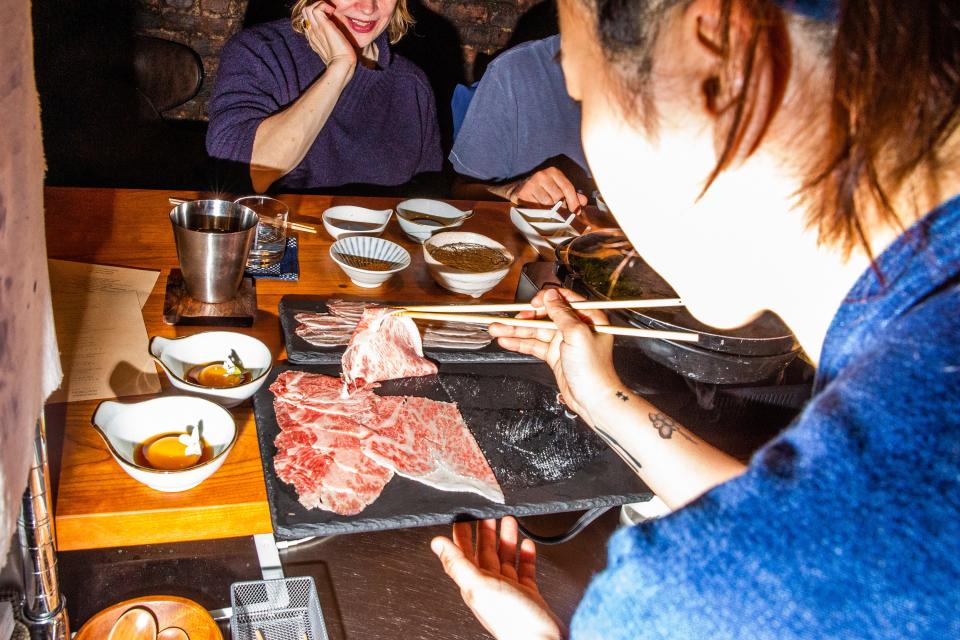
Which brings us back to the emotional seesaw of comfort and challenge, refuge and derangement. Let me end, then, with two more nights. This time in Chicago and New York, and separated by two months, but nevertheless intimately connected. Call it A Tale of Two Omakases.
I first tasted Otto Phan's fish three years ago, when he was operating a strange little sushi place in Austin. Though I couldn't make it to one of his omakase dinners, a friend insisted I stop for lunch on my way out of town to try the work of this young Vietnamese-American prodigy. Kyōten Sushiko turned out to be located in what looked like a onetime dentist's office. I was served a chirashi plate in a paper bowl and a can of tea that may have been warmed in the dishwasher. It was the best raw fish I ate all year.
Last year, Phan decided that he'd outgrown Austin. He looked at a map and searched for the largest city in America that didn't have a Michelin-starred sushi restaurant, settling on Chicago, where he immediately set about winning friends by telling the Tribune, “There is no good sushi in Chicago.”
“I am a tier-one talent. I wanted to be in a tier-one city,” he told the group of us gathered around the eight-seat counter at Kyōten for $220 omakase dinners. “And that's all she wrote.”
Well, okay! The move north has not improved Phan's interest in interior design, though I suppose the generic space he found for Kyōten—not dependent on foot traffic, he figured he'd save on overhead—might be an upgrade from dentist to orthodontist. But sushi has always had a utilitarian aesthetic; consider the amount of Saran Wrap. The proof is in the nearly absurd constraints of a perfect bite—the no-room-for-error high-wire act of melding fish and rice, naked nature and human manipulation. In this, Phan lives up to his outsize ego. His sushi is strongly influenced by the Tokyo-born style of sushi-making called Edomae, which emphasizes the human touch, mostly in the form of well-chosen sauces and curing techniques. His flavors border on aggressive. Kohada, or gizzard shad, is cured, marinated, and then aged in olive oil, giving it both the luscious slipperiness of Spanish boquerones and the sweetness of Scandinavian herring. Toro tuna appears first bare and then is brushed by a piece of lit charcoal and garnished with yuzu zest. A squib of Royal Red shrimp, briefly blowtorched and painted with a buttery shrimp-shell reduction, brought me at once to both Tsukiji Market and Gulf Shores, Alabama.
Phan rightly rests his reputation on rice. He uses a large-grain variety, called Inochi-no-Ichi, that he claims no other U.S. restaurant uses for sushi, the rest going to make rice balls and hotel risottos. The grains, treated with vinegar, look like they've been magnified to 200 percent on a computer screen. Preparing a batch, he narrates, “I don't do it any different than my YouTube video.” I thought he was going to say “ancestors,” but what do I know? It's hard to say how much of the cockiness is a put-on or whether Phan is in on the joke. I found his stream of patter throughout dinner endearing—especially since my eyes were often closed in appreciation of what he was feeding me—but one's mileage may vary. A woman I know who ate at Kyōten on a different night described her experience as similar to “waking up bound in the home of a serial killer who wants to chat before beginning the dismemberment,” which does tend to dampen the appetite.
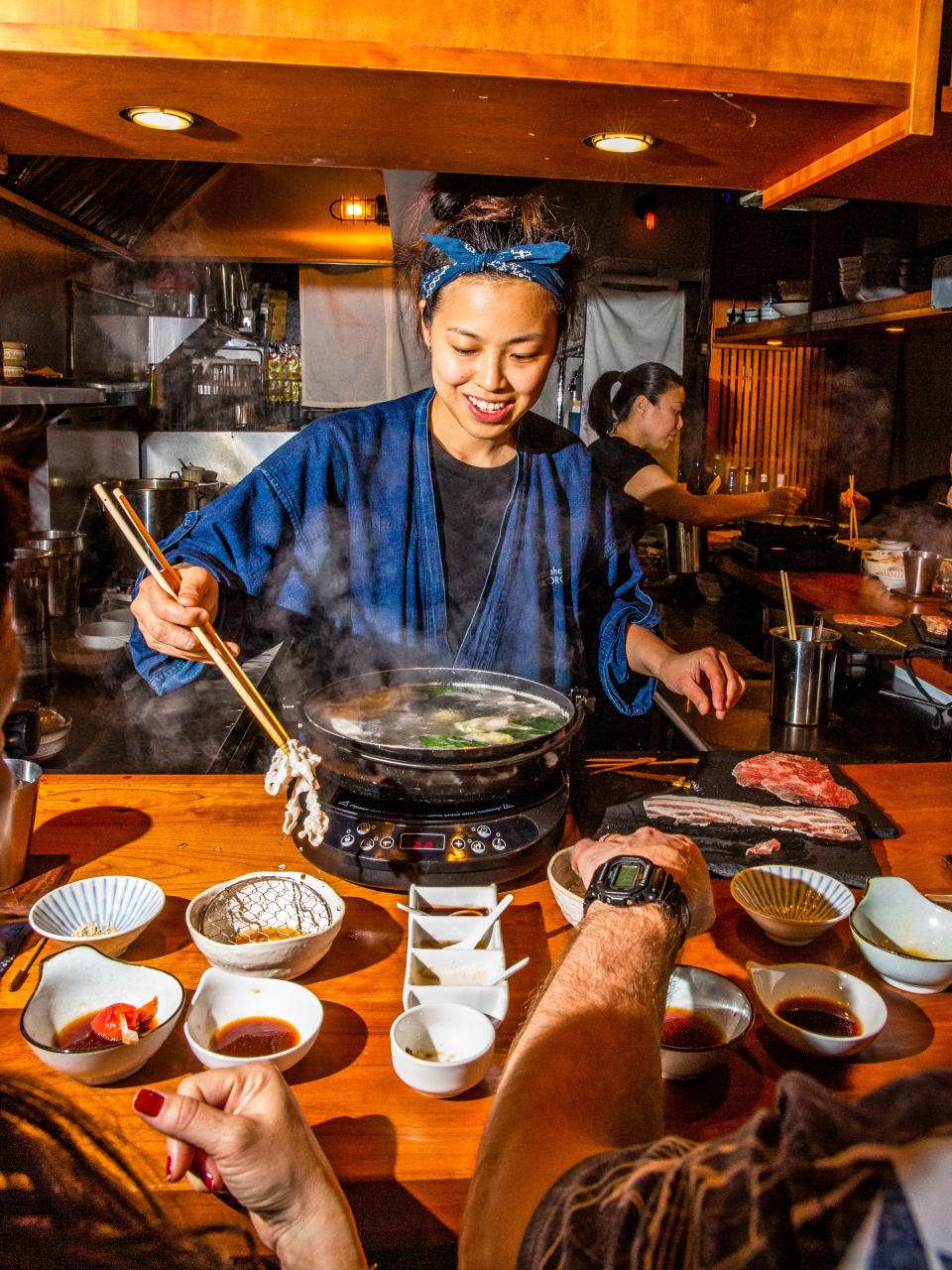
Make of it what you will that it was the same woman who urged me to go to another omakase, Shabushabu MACORON, on New York's Lower East Side. Here again: eight seats around a counter; minimal decoration; a focused, perhaps obsessive young chef practicing esoteric Japanese arts at its center. Otherwise, it was a change in atmosphere so dramatic that had there not been two months between the meals, I might have gotten the bends.
Shabushabu MACORON is the domain of Mako Okano, a 33-year-old from Osaka. She has turned the humble art of hot-pot cooking—far less fetishized than sushi—into something nurturing, revelatory, and precise. The phrase that comes to mind is “slipping into a warm bath,” except that's too easy, given the context. Assisted by two other women, Okano begins with a handful of bites: a square of chargrilled Wagyu beef, adorned with tiny, bitter flower petals, to wake your taste buds; then a curled sliver of sweet abalone and a rolled Japanese omelet Jacques Pépin would be proud of. The menacing black slab of an induction burner then appears before each seat, surrounded in short order by a basket of raw vegetables, five dishes of different sauces, and a palette with slices of beef and pork so thin they look like smears of paint. This, essentially, is Okano's mise en place. For the next hour or so, she moves up and down the counter, dipping and swirling meat or vegetable in each pot of broth while giving instructions on which sauce to use before eating. I was bereft and slightly panicked when, in the final stages, she said, “Now you've tried everything. You can choose.”
Shabu-shabu is not the most aesthetically pleasing food: Vegetables emerge from the pot looking more or less like wilted, wet vegetables; the ribbons of curled brown beef resemble discarded pantyhose. Okano and her assistants turn it into not only a delicious meal but an embrace of hospitality. “May I add ice to your water?” one asked me when she noticed me sweating in the steam of the hot pot. And there can be no more elementally comforting gift than the final savory course of soba, cooked in a blend of the stock that has been formed in your hot pot and a flavorful broth of tomato and Parmigiano-Reggiano cheese—an explosive flavor burst to match the opening taste of steak.
Without consigning two extraordinary chefs to the prison of type, there are obviously deep issues of culture at play here, and even deeper issues of gender. What is permissible for what kinds of restaurants? Who gets to brag? Who needs to brag? Who gets rewarded for what kinds of performances in the wide-open world of what it means to be a chef today? I don't have definitive answers. To me, these meals, plus dozens more I ate in the first months of 2019, exist in ongoing conversation—if only in my belly and later in my rapturous recollection.
Brett Martin is a GQ correspondent.
A version of this story originally appeared in the May 2019 issue with the title "GQ's Best New Restaurants 2019."

